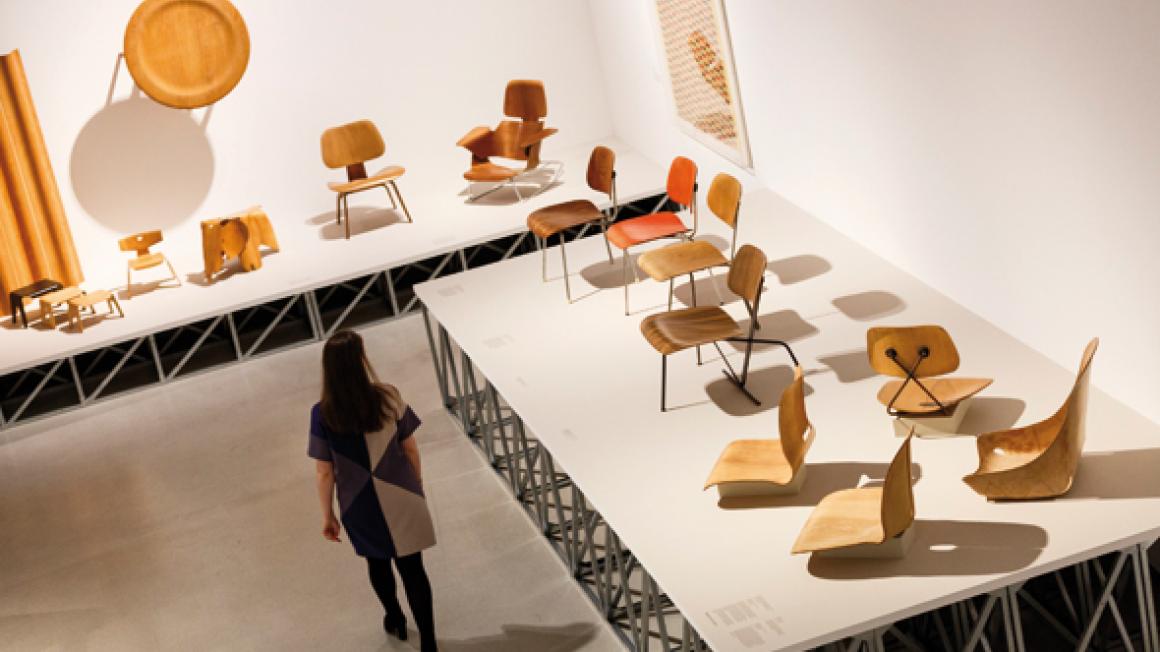The World of Charles and Ray Eames
 Charles and Ray Eames, as celebrated modernist furniture designers, produced many prototypes – but, their heyday being America in the 1940s and 1950s, they were themselves prototypes for people like Terence Conran, Philippe Starck and the whole idea of ‘design’, as opposed to architecture, which has now become mainstream. ‘Design’ almost always means modern design and involves much more than owning a few pieces of minimal furniture – it’s a whole way of life. The Eameses, as this exhibition explains, were rooted in the ‘difficult’ inaccessible modernist traditions of cubism and Joan Miró but ended up launching their famous lounge chair and ottoman on NBC television in the 1950s (a battered example on view here). They developed techniques for mass-production at low cost of chairs in moulded fibreglass, wire mesh and plywood. Just about every office chair you’ve ever sat in, if it has a single pillar supported by splayed tripod feet and swivelling moulded bucket seat, will have been influenced by the Eameses.
Charles and Ray Eames, as celebrated modernist furniture designers, produced many prototypes – but, their heyday being America in the 1940s and 1950s, they were themselves prototypes for people like Terence Conran, Philippe Starck and the whole idea of ‘design’, as opposed to architecture, which has now become mainstream. ‘Design’ almost always means modern design and involves much more than owning a few pieces of minimal furniture – it’s a whole way of life. The Eameses, as this exhibition explains, were rooted in the ‘difficult’ inaccessible modernist traditions of cubism and Joan Miró but ended up launching their famous lounge chair and ottoman on NBC television in the 1950s (a battered example on view here). They developed techniques for mass-production at low cost of chairs in moulded fibreglass, wire mesh and plywood. Just about every office chair you’ve ever sat in, if it has a single pillar supported by splayed tripod feet and swivelling moulded bucket seat, will have been influenced by the Eameses. Through archive footage of manufacturing and actual examples, this exhibition puts all this across in a lively and informative way. The Eames sound fun, not grim and austere like some of the modernists. They liked corresponding by means of pieces of pink paper with child-like drawings. A mock-up of a room they did for an exhibition in the late 1950s has lots of nice bright colours and an attractive cloud-shaped wall sculpture. Their home, the Eames House, in California, although a classic modern glass box, was deliberately surrounded by trees – because they liked the ever-changing reflections on the glass. They didn’t think of themselves as artists and weren’t pretentious.
They were, though, just a bit bonkers. Charles, in particular, made films. One shown on eight separate screens, seems to be about computers – it’s just a very complicated way of saying that it would be a good idea to collect more data in one place. Another is about teaching mathematical concepts ‘through a series of interactive mechanical devices’ – quite lost on me, I’m afraid. They were interested in education and latterly thought to educate India, the main thrust being that everywhere you look in India you often see something nice that’s been designed.
None of this is helped by appallingly pretentious captions and introductory material. ‘They were driven by philosophical ideals that favoured knowledge, discovery and discipline.’ This doesn’t mean anything.
Until 14 February 2016 at Barbican Art Gallery, Silk Street, London EC2: 020-7638 8891, www.barbican.org.uk


